Everyone keeps telling you that email marketing is the backbone of most online business models.
And I agree.
A popular study by DMA found that for every dollar you spend on email marketing, you can expect an average return of $42.
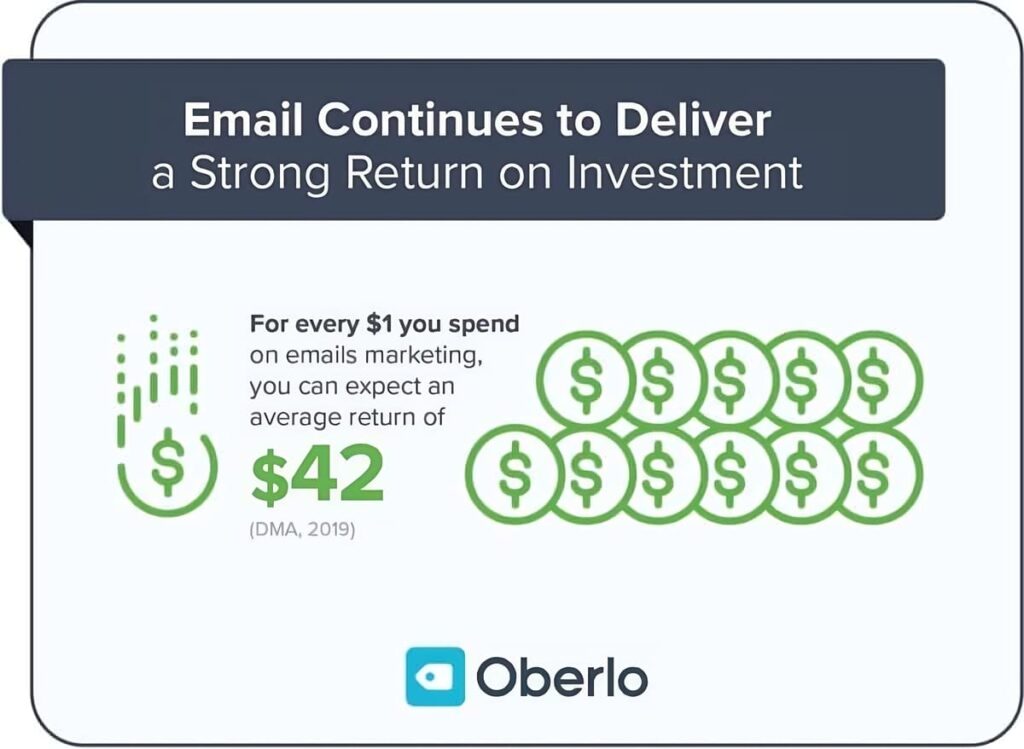

Source
That’s an insane ROI.
But what does that tell you about the value of your email list?
What what is the worth of an email subscriber to your business in monetary terms?
How much value do you gain by adding an additional subscriber to your email list?
You should know the answers to these questions becuase it has a direct impact on the overall profitability of your online business.
If you don’t know the answers, I’ll tell you exactly how to find them in this article.
I’ll tell you exactly how to calculate the value of your email subscribers and use it to measure the ROI of your marketing campaigns.
Keep reading.
In any business, it is important to know how much your email list is worth. Especially if you have a blog and rely on subscribers to make income.
Vice President of Strategy and Marketing at financial advisory startup Carbon Collective, Breene Murphy, notes, “We work in an industry where customer trust is everything. An email list strategy was an integral part of our marketing from the beginning. Gain trust and you win everything. Lose it and, well, it wouldn’t be pretty”
And to really know what our email list is worth we need to break it down to each individual subscriber and look at much they are worth.
Knowing your subscriber value is the key to being able to estimate your direct income from your list and is an important metric for email building. It’s even more important than your opt-in rate and your unsubscribe rate.
To make this really clear, the reason why it’s so important is because I’m assuming you’re not just growing a business as a hobby, but you’re actually trying to make money from it, right?
And in order to make money, it’s important to understand the different actions it takes for an email to turn into a purchase.
To start making money with an email list, consider buying an existing website or online business that comes with an established email list. Browse the Investors Club listings to see businesses for sale.
Clickthrough-Rate And Conversion Rate – The Key Metrics To Track
You and your team should be keeping track of 3 key email marketing metrics:
How many open the email
How many click the link inside your emails
How many unsubscribe
Lucky for us, we can break these steps down into metrics to help us calculate how much our email list is worth with the Click Through Rate (CTR) and the Conversion Rate (CR).
Let’s skim these over:
What is Clickthrough Rate (CTR) in Email Marketing?
Clickthrough Rate (CTR) in email marketing refers to the percentage of your subscribers who open your email and click on a link in your message.
CTR stats often come off as underwhelming. And unfortunately a low CTR means fewer leads in sales which will affect your income 🙁
The first step is to find out what is the average click through rate you should aim for.
Although it’s a little difficult to gauge since many sources say different things. It also depends greatly on the industry in which the email lists are in.
For example, according to Mailchimp, email marketing and advertising has an open rate of 16.48% and a click through rate of only of 1.74%.
That means if you send out 1000 emails, 165 will be opened and your link will be clicked by 17 people.
But as you can see here in Mailchimp’s chart updated in March 2018, these numbers change drastically from industry to industry.
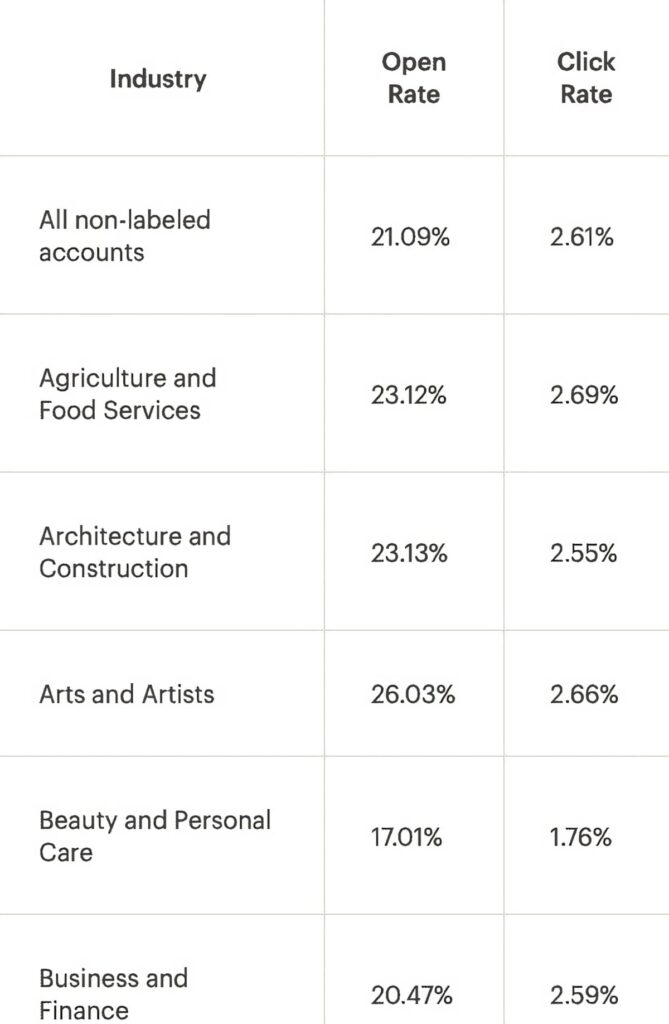

Here are some extra tips to boost your CTR:
Build Trust With Your Subscribers
You can’t sell to your subscribers unless they trust you. There’s already a certain level of trust between you and your subscribers since they’ve willingly joined your email list.
But you need to grow and build this trust by sending them high-value email content regularly and following email marketing best practices. Instead of trying to sell all the time, share tips, experiences, and actionable insights with your subscribers.
Once they start trusting you, they won’t hesitate to click on your offers and links in your emails.
Nail the Call To Action (CTA) In Your Emails
A Call To Action (CTA) is the link/button in your email body content that invites your subscribers to click on it and visit your offer page.
To improve your email CTR, you need to create compelling CTAs that generate interest in your subscribers.
For example, instead of using a simple CTA like “Click Here” try something like “Activate Your Free Trial Now!”
Do you see the difference?
The second CTA is much more descriptive and sounds inviting.
As a result, it’s likely to drive more clicks.
Segment and Personalize Your Email Campaigns
A segmented email campaign is sent to a well-defined segment of your subscribers instead of your whole email list.
A study by SmartInsights shows that segmented email campaigns have a much higher clickthrough rate (CTR) than non-segmented campaigns
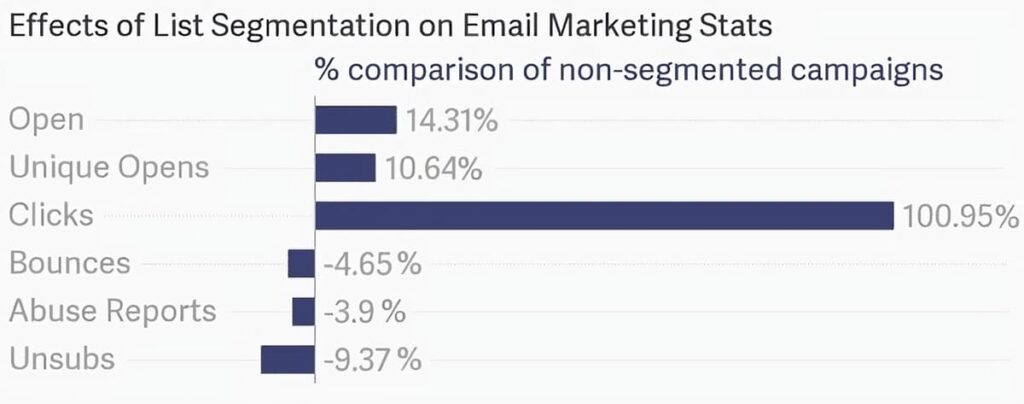

Source
The reason is simple.
Segmented campaigns are targeted towards the exact problems of your audience as compared to generalized emails.
Frequently Email Your Subscribers
To stay on top of your subscribers’ minds, you need to regularly send them emails (at least once per week).
If you leave them unattended for too long, they’ll forget you because they’re bombarded with emails from so many different brands all the time.
Naturally, they won’t click on your offers when they don’t even remember you.
Improve Email Content
Your email content deserves the same respect as your blog content.
Don’t write emails casually from the top of your head.
Plan your email marketing campaign like you plan blog content, create email content themes, share actionable tips, and give them real value.
When you give free value consistently, people become more interested in your paid offers and expect you to deliver nothing short of excellence.
You can always use this CTR calculator as well if you are unsure of your numbers.
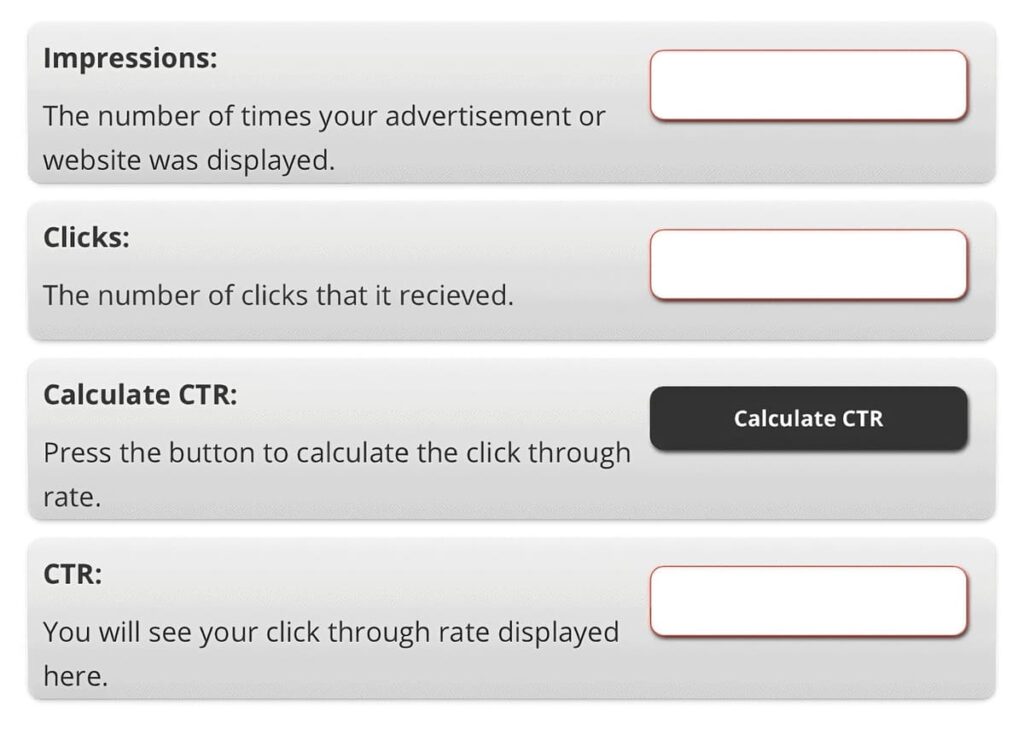

What Is Conversion Rate (CR) In Email Marketing?
Your sales conversion rate is an excellent way of tracking the effectiveness of your messaging as well as the product behind the message.
In other words, it is the actual percentage of people that gave their email in exchange for your lead magnet or the number of people who made purchases in exchange for your product.
Math is hard so let’s use an easy example:
If you send an email to 100 people and 10 people buy your product, then you have a conversion rate of %10.
And if you have trouble with calculations, there are softwares that can help you out with this like Google Analytics.
And like the CTR, there isn’t a perfect percentage to aim for your conversion rate. It varies from industry to industry.
Here is a chart of the average conversion rates in different industries by Smart Insights.
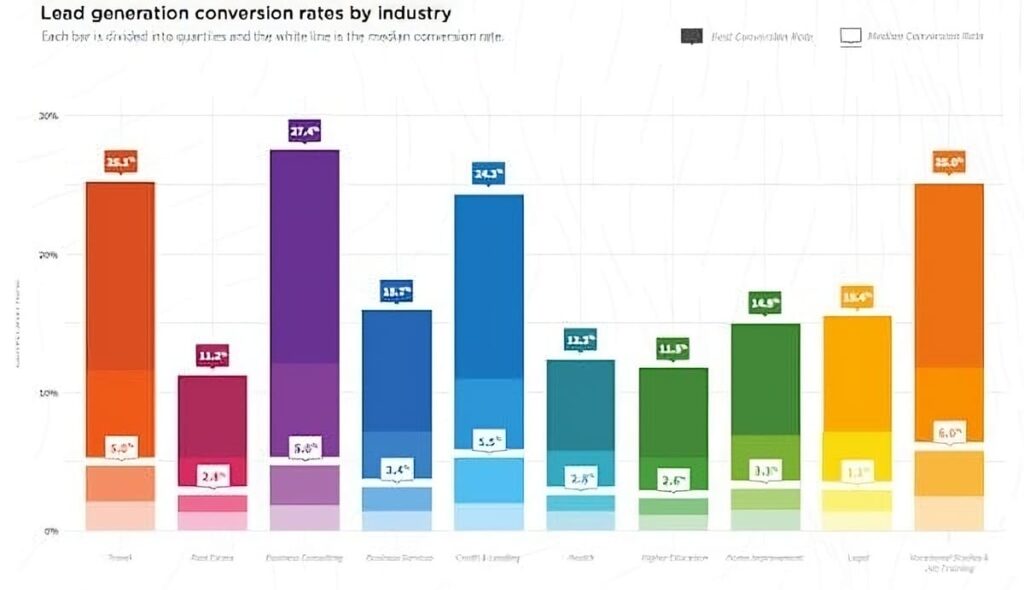

Some tips to boost your conversion rates:
Make your offer clear
Tell your subscribers exactly what they’ll get by taking your offer. Don’t use vague terminologies or overly complex copy just to look creative.
Audit your sales landing page
Test different variations of your landing page (A/B Testing) to see which one gets the highest conversions.
Remove any/all distractions
Your landing page should be clear of any elements that can distract the user from your main call to action. Remove unnecessary links, navigation links, side bar, footer links and anything else that doesn’t serve a clear purpose towards your offer.
Use trust symbols on your page
Secure payment badges, money back guarantee, encrypted payment, testimonials etc. add credibility to your landing page and help in removing any doubts your visitors might have.
Test different incentives
Try using different incentives and bonus offers with your core offer to see how they impact sales. Stick with the one that brings the highest conversions.
So How Do We Really Know What Our Subscribers Are Worth?
1. Go see how many subscribers you currently have.
This seems simple and straightforward but consider skimming through your list and shedding a layer. Check out how many have been inactive for 6 months or longer. When I say inactive, I mean the ones who haven’t opened or clicked any of your emails.
Now, throw those email addresses out. Don’t be disappointed if you end up losing more than you thought because you can always create a project to get them back. But more importantly, think of ways to get emails from new people on your list.
After you’ve done your cleanup to remove inactive subscribers, you can now use the current number to calculate how much your email list is worth.
2. Find out how much revenue you’ve made from that list – over the last year
Calculate your direct revenue from over the last year.
The reason I suggest calculating the revenue from the last year instead of the lifetime value is because it’s possible that your business hasn’t been up and running or making very much income for 3 years already.
And it’s possible that you haven’t even been actively selling or tracking your income. If you have, feel free to use the last three years in your calculations.
If not, using the last year will give you a much better/accurate calculation.
So within the last year you need to figure out 2 things:
How much revenue you’ve made directly from your list.
How much revenue you’ve made indirectly from your list.
Yes, there is a difference.
What I mean by “directly” is the income you’ve made from people opening the email, clicking the link, entering their payment info and buying something. Those are profits you made from sending the email.
Indirect is income from everything else not email related and should be put aside while making this calculation.
3. Okay, let’s calculate
Now that we’ve got our number of subscribers and last years income that we’ve made as direct revenue from our email list, let’s do the math.
Here it goes:
Number of subscribers/last year’s income = subscriber value
To make it extra clear here is an example:
You have 2500 subscribers.
Last year’s income was $10,000 strictly from direct income.
2,500/10,000=0.25
SO, in this case your subscriber value would be 25 cents per subscriber.
And your mailing list would be worth $10,000.
Optional extra step: Calculating Our Time As Expenses (not For everybody)
This isn’t for everybody and only for people who want to calculate every aspect of their email list value.
Most online entrepreneurs don’t calculate their time as expenses into their business. But if you’re somebody who does, then this parts for you!
And we must not forget about our overhead costs for email production and our time writing these emails.
This means the time that it took you to write and fabricate the email, as well as how much you pay for your email service provider.
Depending on the kind of emails you send, it’s easy to work up to 3 hours for one weekly email. That’s a good chunk of time.
Here are some examples of typical costs of sending out emails on the regular:
Email service provider – $40 per month = $480 per year.
Your time – 2 hours per week. Let’s choose a random amount and say our time value is $80 per hour. Cost per week = $160. Cost per month = $640. Cost per year $7,680.
Email template design = $300.
These add up to a total of:
$8,460 in total costs.
So now if we take last year’s direct income and subtract the costs:
$10,000 – $8,460 = $1,540
$1,540/2,500 (number of subscribers) = 0.61 cents subscriber value.
0.61 cents subscriber value.
Whoooh.. Go take a break. You deserve it. That was a lot of thinking and math.
Bonus: How to figure out your time value
What do you make each day? How many hours do you work?
Let’s say you make $200 per day and you work 8 hours per day.
$200/8 = $25
Your time value is $25/hour
Check out this guide from Study.com. To sum up what they said, a more in depth calculation should go as follows:
PV = FV / (1 +r)^n
And just to clarify this,
PV = present value of email list
R = Interest rate that will be earned
N = number of periods before money is needed
FV = Future Value
What’s Next?
Now that you have your subscriber value, you can go ahead and add this number to whatever analytics software you are using. You can incorporate a dolar value to your goal.
And now, you can also use your subscriber value to measure list building tactics and maximize your email ROI.
Let’s say you are running Facebook Ads (or ads on other social media platforms) and paying 30 cents per new subscriber. Wow! This is half of your subscriber value, which means more money for you… At least it seems that way.
But remember to always consider your overhead costs, specifically your time value.
How much time are you spending managing these Facebook Ads? Some of us, and I must admit guilt to this too, spend at least an hour per day just looking over accounts and ditzing around.
That means if your time is worth $80/hour, you are spending that amount an hour per day. Where you really need to be careful is the number of subscribers you are gaining per day from these Ads. If you’re only getting 10 new subscribers, with time costs and other overhead costs involved, you are now spending $8 per subscriber, not 30 cents.
Here is a break down of that calculation:
$80 (time value per hour)/10 (subscribers per day) = $8 paid for each subscriber.
To lessen this amount, stick to just doing the necessary things and use your time wisely! No ditzing around.
Conclusion
In email marketing, there are so many components that go into the calculation of your subscriber value. Once you’ve got the magic number, you can really gage your list building tactics and how much money you’re allowed to spend in order to collect more email addresses and make a profit.
It can also make you realize how important having an email list is and how to manage it properly.
Just remember that your time does cost money, possibly quite a lot of money, too. So be careful with it and use it wisely.